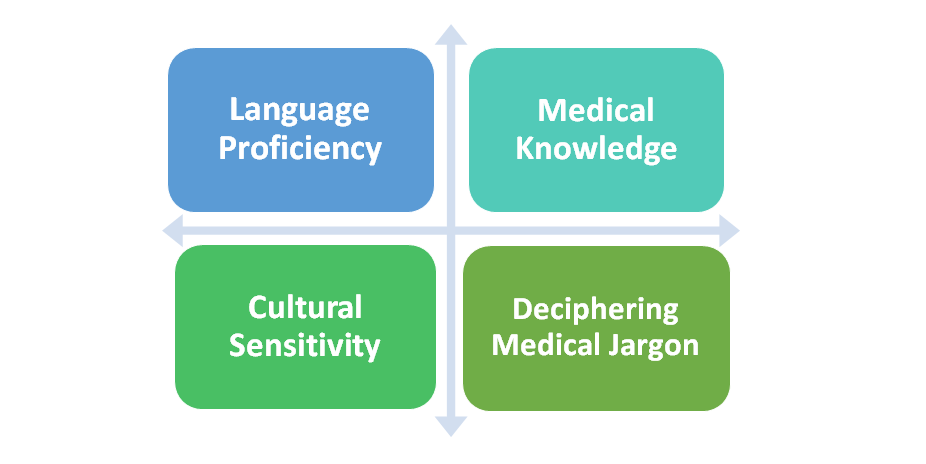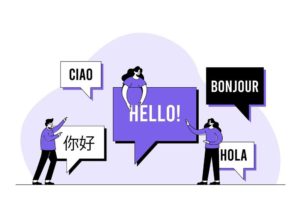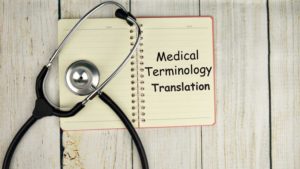Imagine you’re an English Speaker in a foreign Spanish-speaking country, and you suddenly fall ill. You’re rushed to a hospital, but there’s one problem: you can’t speak the language. In this critical moment, a medical translator who can translate from English to Spanish becomes your lifeline, ensuring that you receive the care you need by accurately translating from English to Spanish or any other language.
The Significance of Medical Translation
Medical translation isn’t just about words; it’s about preserving lives and well-being. Translation errors can lead to misunderstandings, misdiagnoses, and even jeopardize patient safety.
Let’s delve into what it takes to be a medical translator and how they bridge language and culture gaps in healthcare.
The Qualities of an Effective Medical Translator
Being an effective medical translator is not just about knowing two languages; it’s about possessing a unique set of qualities that make you exceptional in bridging language and culture gaps in healthcare. Here are the key qualities:

1. Language Proficiency
An effective medical translator must be exceptionally proficient in both the source (English) and target (Spanish) languages. It’s not merely about speaking or understanding the languages but having a deep and nuanced understanding of them.
Consider a medical document that includes complex medical instructions in English. A proficient translator can translate this document accurately into Spanish, ensuring that the message remains clear and precise.
2. The Crucial Role of Medical Knowledge
Medical translation isn’t just about language; it’s also about understanding medicine. A good medical translator should know medical terminology, procedures, and concepts.
For instance, translating “myocardial infarction” into “infarto de miocardio” requires in-depth medical knowledge.
3. Cultural Sensitivity
The importance of cultural sensitivity in medical translation cannot be overstated. Different cultures have distinct views on health and wellness.
A skilled medical translator ensures that the translated content is culturally appropriate and respectful.
For example, in English-speaking cultures, direct and explicit communication may be preferred, but in Spanish-speaking cultures, a more indirect or polite approach might be necessary. A culturally sensitive translator can adapt to these nuances.
4. Deciphering Medical Jargon
Medical texts are often laden with complex jargon and technical terms. A medical translator’s role is to decode these terms accurately.
For instance, translating “electroencephalogram” to “electroencefalograma” requires an understanding of both the term’s meaning and linguistic nuances.
The Step-by-Step Process to Translate from English to Spanish
Translating medical content from English to Spanish is a meticulous process that involves several well-defined steps.
Think of it as a carefully choreographed dance, where each step is crucial to ensure the accuracy and effectiveness of the translation. Let’s break it down:

- Understanding the Source Text: The process begins by thoroughly understanding the source text, and grasping the medical concepts and terminology. For instance, if the source text mentions “coronary artery bypass grafting,” the translator needs to understand the procedure and its significance in the medical context.
- Identifying Key Medical Terms: Medical documents are often filled with specialized terms and jargon. In this step, the translator identifies the key medical terms and phrases that require translation.
- Research and Validation: Once the key terms are identified, the translator embarks on research. They need to find the equivalent terms in the target language, in this case, Spanish. For example, the translator needs to research and validate that “magnetic resonance imaging” should be translated as “imagen por resonancia magnética.”
- Translation: Now comes the core of the process – translation itself. The translator crafts a translated version that is not only accurate but also clear and culturally sensitive. It’s essential to capture the essence of the source text while making it accessible to the target audience.
Tools and Resources Require to Translate from English to Spanish
Medical translation is a complex field, and to excel in it, professionals rely on a range of tools and resources.
These tools aid in accuracy and efficiency, and ensure that the translations are both precise and culturally sensitive.
Here, we’ll explore some of the key tools and resources used by medical translators, along with examples of how they are applied.
- Medical Dictionaries
- Glossaries
- Translation Software
1. Medical Dictionaries
Imagine you’re translating a medical document, and you come across the term “gastroesophageal reflux disease” in English.
A medical dictionary can provide you with the accurate Spanish equivalent, which is “enfermedad por reflujo gastroesofágico.” This tool helps you find the right medical terminology quickly, ensuring precision in your translation.
2. Glossaries
Let’s say you’re translating a patient’s medical history, and you need to consistently use the same terms throughout the document.
A glossary specific to the medical institution you’re working for can provide you with a list of approved translations, ensuring consistency and adherence to institutional standards.
3. Translation Software
Translation software, such as Emtran Pro, can be invaluable for medical translators. These tools store translation memories, which means that once a term or phrase is translated, it’s saved for future reference.
For instance, if you’ve translated “diabetes mellitus” to “diabetes mellitus” previously, the software will suggest the same translation, saving you time and maintaining consistency.
The Challenges to Translate from English to Spanish

Medical translators face various challenges, such as regional variations in medical terminology, evolving medical practices, and the constant need to update their knowledge to stay relevant and accurate.
Let’s have a look at two of the most common challenges.
- Regional Variations in Medical Terminology
- Evolving Medical Practices
1. Regional Variations in Medical Terminology
Medical terminology can vary between regions and countries, even when the same language is spoken.
For example, consider the term “stomach” in English. In the United States, it’s commonly referred to as the “stomach,” while in the United Kingdom, it’s often called the “tummy” or “abdomen.”
A medical translator needs to be aware of these regional differences to ensure that patients receive accurate information.
2. Evolving Medical Practices
Medicine is a rapidly evolving field. New treatments, procedures, and medications are constantly being developed.
For instance, in recent years, groundbreaking advancements like mRNA vaccines for COVID-19 have emerged. Medical translators must stay up-to-date with these developments and be ready to translate new terms and concepts.
Keeping up with the latest medical research is crucial to providing accurate translations.
Conclusion
In the world of medical translation from English to Spanish, precision, knowledge, and cultural sensitivity are paramount. Medical translators play a vital role in ensuring accurate communication in healthcare, making sure that patients can receive the care they need, regardless of the language they speak.
FAQs
To translate a medical document, you need strong language skills in both source and target languages, a deep understanding of medical terminology, and attention to detail. Carefully interpret and accurately convey medical information, maintaining precision and clarity.
To become an English-to-Spanish translator, gain fluency in both languages, acquire knowledge of medical terminology, and consider formal translation training or certification. Build a strong portfolio to showcase your translation skills.
Translators translate by comprehending the source text, identifying key terms, researching equivalents, and crafting a translated version that’s accurate and culturally sensitive. Proofreading and quality control ensure a high-quality translation.
Translators work with written text, converting documents, medical records, or literature from one language to another. Interpreters, on the other hand, provide real-time spoken language translation, facilitating communication in person or over the phone during medical appointments.







